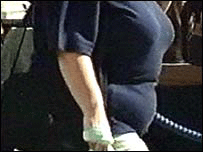Even a small pot belly can increase the risk of heart disease, scientists warn.
Research from the University of Texas found large waist measurements, relative to hip size, were linked to early signs of heart disease.
This confirms other research that waist size, rather than overall body weight, is a key indicator of heart disease.
The study of 2,744 people suggests that a waist size of 32ins (81cm) for a woman and 37ins (94cm) for a man represents a “significant” raised risk.
The report was published in the Journal of the American College of Cardiology.
|
Professor James de Lemos
|
The authors looked at men and women who underwent medical tests and imaging scans to identify the early signs of atherosclerosis – the narrowing and hardening of the arteries linked to the development of cardiovascular disease.
Body shape important
They then examined the relationship between the participants’ body shapes and the presence of atherosclerosis.
They found adding a few inches to the waist increased the risk of damage in the arteries, even if body weight remained within the normal range.
People with the largest waist-to-hip ratios (WHRs) were almost twice as likely to have calcium deposits, which indicate the onset of atherosclerosis, in the arteries of their hearts, as those with the smallest WHRs.
 |
And even when other risk factors such as blood pressure, diabetes and age were taken into account, the link remained strong.
Professor James de Lemos, who led the research, said: “Fat that accumulates around your waist seems to be more biologically active as it secretes inflammatory proteins that contribute to atherosclerotic plaque build-up, whereas fat around your hips doesn’t appear to increase risk for cardiovascular disease at all.
“We think the key message for people is to prevent accumulation of central fat early on in their lives.
“Even a small pot belly puts us at higher risk when compared to a flat tummy.”
Abdominal fat risks
And waist-to-hip ratio was more closely linked to these early signs of heart disease than either body mass index (BMI) or waist circumference alone.
BMI is widely used to assess relative body weight, and is calculated as weight in kilograms divided by the square of the height in metres.
June Davison, cardiac nurse at the British Heart Foundation, said: “People who are overweight or obese have an increased risk of developing heart disease.
“The risks are even higher when fat is mainly concentrated around the abdomen.
“What’s important is that people consider their body shape as well as their weight.
“Controlling both by eating less and being more active is an effective way to reduce your risk of heart and circulatory disease.”
Dr Ian Campbell, medical director of charity Weight Concern, said even just measuring waist circumference could be useful to assess abdominal fat levels and risks of disease.
He said: “The beauty of it is that it is simple, reproducible, and both patients and doctors/nurses can measure and understand it.”
Previous studies have suggested that a waist circumference of over 35in (88.9cm) for a woman, and 40in (101.6cm) for a man indicates a high risk of developing diabetes and heart disease.
Even a waist circumference of 32in (81.3cm) for a woman, and 37in (94cm) for a man represents a “significant” raised risk.
